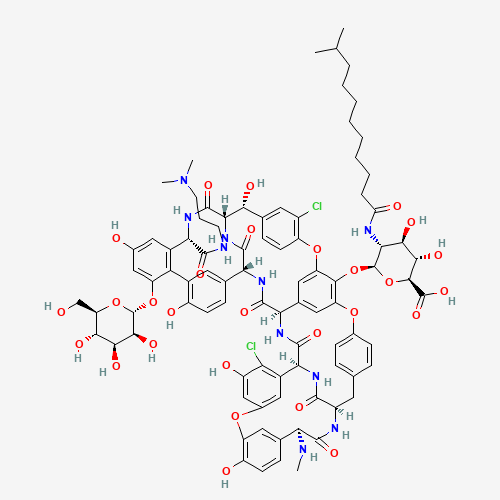| Pharmaceutical Information |
| Drug Name |
Dalbavancin |
| Drug ID |
BADD_D00572 |
| Description |
Dalbavancin is a second-generation lipoglycopeptide antibiotic that was designed to improve on the natural glycopeptides currently available, such as vancomycin and teicoplanin [A4072, A4073]. Modifications from these older glycoprotein classes facilitated a similar mechanism of action for dalbavancin but with increased activity and once-weekly dosing [FDA Label, F2356, A4072, A4073]. Its use is indicated for the treatment of acute bacterial skin and skin structure infections (ABSSSI) caused by the following gram-positive microorganisms: Staphylococcus aureus (including methicillin-susceptible and methicillin-resistant strains), S. pyogenes, S. agalactiae, S. dysgalactiae, the S. anginosus group (including S. anginosus, S. intermedius, and S. constellatus), and Enterococcus faecalis (vancomycin susceptible strains) [FDA Label, F2356]. Dalbavancin acts by interfering with bacterial cell wall synthesis by binding to the D-alanyl-D-alanine terminus of nascent cell wall peptidoglycan and preventing cross-linking [FDA Label, F2356, A4072, A4073]. |
| Indications and Usage |
Dalbavancin for injection is indicated for the treatment of adult patients with acute bacterial skin and skin structure infections (ABSSSI), caused by susceptible isolates of the following gram-positive microorganisms: Staphylococcus aureus (including methicillin-susceptible and methicillin-resistant strains), Streptococcus pyogenes, Streptococcus agalactiae, Streptococcus dysgalactiae, Streptococcus anginosus group (including Streptococcus anginosus, Streptococcus intermedius, Streptococcus constellatus) and Enterococcus faecalis (vancomycin susceptible strains) [FDA Label, F2356].
Dalbavancin is not active against gram-negative bacteria; therefore, combination therapy may be clinically indicated if the ABSSSI is polymicrobial and includes a suspected or documented gram-negative pathogen [F2356].
To reduce the development of drug-resistant bacteria and maintain the effectiveness of dalbavancin and other antibacterial drugs, dalbavancin should be used only to treat infections that are proven or strongly suspected to be caused by susceptible bacteria [FDA Label, F2356]. When culture and susceptibility information are available, they should be considered in selecting or modifying antibacterial therapy [FDA Label, F2356]. In the absence of such data, local epidemiology and susceptibility patterns may contribute to the empiric selection of therapy [FDA Label, F2356]. |
| Marketing Status |
approved; investigational |
| ATC Code |
J01XA04 |
| DrugBank ID |
DB06219
|
| KEGG ID |
D03640
|
| MeSH ID |
C469289
|
| PubChem ID |
16134627
|
| TTD Drug ID |
D07QAR
|
| NDC Product Code |
57970-100; 82297-102 |
| UNII |
808UI9MS5K
|
| Synonyms |
dalbavancin | Zeven | BI-397 | BI397 | BI 397 | MDL 64,397 | MDL-64397 | Dalvance | A-A-1 antibiotic | Xydalba | VER-001 | VER001 |
|
| Chemical Information |
| Molecular Formula |
C88H100Cl2N10O28 |
| CAS Registry Number |
171500-79-1 |
| SMILES |
CC(C)CCCCCCCCC(=O)NC1C(C(C(OC1OC2=C3C=C4C=C2OC5=C(C=C(C=C5)C(C6C(=O)NC(C7=C(C(=C
C(=C7)O)OC8C(C(C(C(O8)CO)O)O)O)C9=C(C=CC(=C9)C(C(=O)N6)NC(=O)C4NC(=O)C1C2=C(C(=C
C(=C2)OC2=C(C=CC(=C2)C(C(=O)NC(CC2=CC=C(O3)C=C2)C(=O)N1)NC)O)O)Cl)O)C(=O)NCCCN(C
)C)O)Cl)C(=O)O)O)O |
| Chemical Structure |

|
|
| ADRs Induced by Drug |
|
|
*The priority for ADR severity classification is based on FAERS assessment, followed by the most severe level in CTCAE rating. If neither is available, it will be displayed as 'Not available'.
**The 'Not Available' level is hidden by default and can be restored by clicking on the legend twice.
|
|
|

